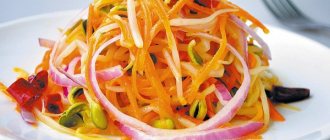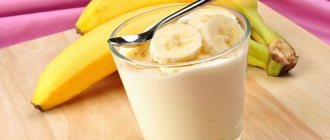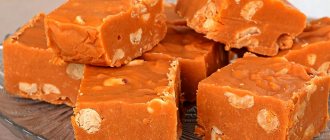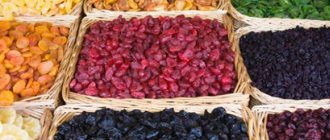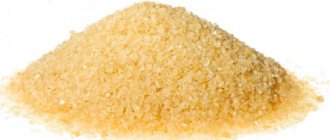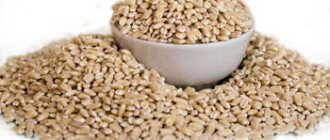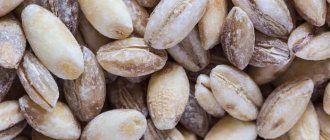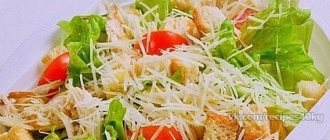Eastern cuisine is becoming more and more popular every day, and its spicy dishes are increasingly appearing on the tables of Russians and Europeans. Today, even the lazy know about the benefits of ginger root, which came to us from distant India. This country accounts for approximately half of all world production. Fresh product is very useful for the human body, but it is not always available and quickly becomes unusable if stored incorrectly. Therefore, let's figure out what the benefits and harms of pickled ginger are, how to use it, and whether there are any contraindications.
Composition of the product
Surprisingly, pickled ginger root has no less beneficial properties than fresh one . Despite the pungent taste, it does not damage the digestive organs - on the contrary, its disinfecting effect has a beneficial effect on the health of the gastrointestinal tract.
This spice contains the following ingredients:
- vitamins A, C, group B;
- amino acids: lysine, tryptophan, threonine, phenylalanine;
- micro- and macroelements (potassium, magnesium, iron, sodium, zinc, phosphorus, copper, calcium);
- essential oils;
- gingerol.
The calorie content of the product is only 28 kcal per 100 g .
Unusual pickled ginger: chemical composition and calorie content
In hot climates, food spoils very quickly. Therefore, in ancient times, people looked for ways to preserve food longer and be able to stock up for future use. Ginger has been found to have powerful antimicrobial properties that help with this task quite well.
In the Middle Ages, ginger root, as well as its pickled variations, was already well known. When the bubonic plague, which was called the “Black Death,” was raging, they tried to stop the epidemic with the help of this spice. Some actually succeeded.
Biochemistry of horned root
The plant itself called ginger has about 150 species. However, in all cases, only the root, which looks like strange figures from witchcraft fairy tales, is used to add to food. There are two types of ginger - black and white, which is directly related to its collection and processing. A root just dug out of the ground belongs to the first type, and after it is washed and cleaned of dirt and unnecessary parts, it belongs to the second.
For pickling, it undergoes preliminary cleaning. It is interesting that at the same time it loses its bright pungent taste, becomes softer and more pleasant, but all the qualities remain with it. This is due to the chemical composition of the plant. The great value of ginger is that it is rich in many beneficial components.
- Amino acids, including essential ones: tryptophan, valine, asparagine, methionine, lysine, phenylalanine, threonine.
- Organic acids: linoleic, caprylic, oleic, nicotinic.
- Essential oils, the lion's share of which are zingiberene and hergenol, there are citral, borneol, camphene.
- Minerals: iron, magnesium, phosphorus, potassium, sodium, zinc, calcium.
- Vitamins: tocopherol, thiamine, riboflavin, ascorbic acid, retinol and many others.
The carbohydrates in this root are expressed as sugars and glucose.
Calories and nutritional value
For those who are on a diet, it will be good news that this root contains practically no calories, either fresh or pickled. But this is not so important, considering that no one eats just ginger without anything else. It cannot in any way be considered a main product or main dish.
An interesting question is how many calories are in pickled ginger? The answer is simple: 100 grams of product contains about 51 kilocalories. All other indicators are also calculated for the same weight of the original product.
- Carbohydrates – 0.2 grams.
- Fiber – 6 grams.
- Water – 40 grams.
Its value lies in the fact that it is saturated with various minerals, micro- and macroelements, although almost half consists of water. Many people say that if dieting is unbearable, you just need to add ginger to your food, and you will steadily lose pounds. Of course, this is subject to a balanced healthy diet, as well as regular physical activity.
Beneficial features
The pickled root has almost the same set of beneficial properties as the fresh one. It has a beneficial effect on many organ systems:
- Digestive system . This spice improves the digestion process, increases gastric secretion and eliminates cramps and flatulence. Thanks to its disinfecting properties, it effectively fights poisoning and quickly destroys parasites. Stops inflammatory processes in the oral cavity, cleans it, and freshens breath.
- Circulatory system .
The product improves cerebral circulation and stimulates the supply of oxygen to brain tissue. It increases mental productivity, eliminates headaches, tones, and provides strength and energy. Equally useful for workers in the intellectual sphere and physical labor. - The cardiovascular system.
It has a beneficial effect on the condition of the heart and blood vessels, as it has the ability to cleanse their walls of accumulations of “bad” cholesterol. Prevents the formation of blood clots, and thanks to the content of potassium and magnesium, it normalizes heart rhythm and improves myocardial function. - Reproductive system. Translated from Chinese, the word “ginger” means “masculinity.” There are few foods as beneficial for men's health as ginger (fresh or pickled).
It fights prostatitis and other inflammatory diseases of the prostate gland, enhances potency, and restores libido.It is also useful for women to eat this spice: it tones the muscles of the uterus and relieves infertility.
- Nervous system . Due to its high magnesium content, the root can have a positive effect on the nervous system: it fights chronic stress and relieves nervous tension.
- Respiratory system . Facilitates the well-being of patients suffering from chronic bronchitis or bronchial asthma.
Pickled ginger is one of the best helpers in the fight against cancer. Prevents the formation of new tumors and slows down the development of existing ones.
High content of antioxidant substances slows down the aging process!
In what form and how to use
The ready-to-eat product does not require additional heat treatment. It is best to eat this spice along with other dishes: meat, fish. Add it to sushi and rolls .
Ginger roots favorably emphasize the taste of these dishes and prevent infection by pathogenic bacteria , which may be contained in raw fish or undercooked meat.
It can be eaten as a separate dish, but it is important not to overdo it: the hot, hot seasoning can lead to irritation of the gastric mucosa . Sometimes the roots become an ingredient in other dishes: they are added to salads, roasts, pies; Meat for barbecue is marinated in juice.
Video about the benefits and possible harm of ginger, how to prepare it at home:
General Health Benefits of Ginger
Ginger has been used as a natural medicine in China for more than two thousand years. Its best known medicinal properties are to relieve nausea and indigestion. But this is not a complete list of the therapeutic capabilities of this plant. Interestingly, gari appeared on a sushi dish for a reason. Spices have not only a gastronomic role. Preserved Ginger is a carefully formulated supplement that provides tremendous benefits to the body:
- Firstly, this delicacy helps get rid of the specific taste in your mouth between eating different types of sushi.
- Secondly, gari has a pronounced antibacterial effect, thanks to which it protects the human body from parasites that could potentially be present in raw fish. By the way, the antibacterial, antimicrobial and antiparasitic effect is enhanced if sushi is eaten with gari and wasabi.
- Thirdly, canned ginger prevents nausea and makes Asian dishes easier to digest.
General beneficial properties
The list of beneficial properties of pickled ginger looks something like this:
- eliminates nausea caused by toxicosis, seasickness or chemotherapy;
- has an anti-inflammatory effect;
- relieves muscle pain;
- reduces joint pain;
- serves as a prevention of Alzheimer's disease;
- prevents cancer;
- reduces blood sugar levels;
- lowers cholesterol;
- thins the blood;
- natural expectorant;
- relieves menstrual pain and PMS;
- slows down the proliferation of bacteria that cause gingivitis;
- has antifungal properties;
- normalizes digestion;
- increases appetite;
- speeds up metabolism;
- treats flatulence;
- stimulates saliva production;
- freshens breath;
- relieves sore throat;
- has aphrodisiac properties.
In addition, the spice has pronounced antioxidant activity, which is necessary for the human body to neutralize free radicals. Several components of the seasoning act as antimicrobial agents. The most active are gingerol and shogaol. They have antimicrobial activity against Escherichia coli and hay bacilli, as well as Salmonella. In addition, gingerol is characterized by an antifungal effect (including against fungi of the genus Candida), as well as an antibacterial effect (against bacteria that cause periodontitis). The exact mechanism of ginger's neuroprotective effects is still unknown, but the spice is believed to exert this activity through phenolic and flavonoid compounds. These substances protect brain cells from destruction.
What is useful for women
One of the most famous medicinal properties of ginger is its ability to eliminate nausea and vomiting. Thanks to these abilities, the spice is considered useful for pregnant women suffering from toxicosis. During a scientific experiment conducted by American specialists with the participation of more than 70 volunteers, it was discovered that ginger has analgesic properties. One small piece of root helps relieve pain by almost 25%. For this reason, the spice is considered beneficial for women with very painful menstruation. The results of another scientific experiment showed that ginger prevents and slows down the malignant degeneration of ovarian cells. It is useful for uterine fibroids, helps normalize hormonal levels in the female body, and increases the tone of the uterus. In some folk recipes, the delicacy is mentioned as a natural cure for female infertility. With age, many women face the problem of thrombophlebitis - when the legs are covered with an unsightly venous network. And in this case, ginger will also come to the rescue: by consuming gari, you can get rid of this problem.
For men's health
In the East, “horned root” enjoys the reputation of one of the most useful products for men. The presence of zinc and most amino acids makes it useful for potency. Ginger snack has the properties of an aphrodisiac product that enhances libido and increases testosterone production. But for men, the benefits of ginger don’t stop there. Scientists suggest that some active components of the spice can protect the prostate gland from various diseases, including prostatitis. Gary may be helpful for men trying to quit smoking. Experts have found that it reduces cravings for tobacco. In addition, the seasoning protects the cardiovascular system of heavy smokers, which is greatly affected by nicotine and tar.
For people over 50 years old
One of the most common diseases among people over 50 years of age is arthritis. And many people don’t even realize that to prevent and treat this disease, they should consume ginger, including pickled ones. Nowadays, scientists have found precise confirmation that this plant contains substances that help treat inflamed joints (osteoarthritis and osteoarthritis). This spice acts on the body of patients as a small dose of the drug Indomethacin. For women during menopause and postmenopause, the product is useful in that it relieves headaches and the symptoms of hot flashes.
See also:
How does ginger affect blood pressure and heart rate?
Contraindications
In moderate quantities, the product is completely safe for the body. But if you eat it as an independent dish, symptoms of poisoning may appear - heartburn, nausea, diarrhea, vomiting. Sometimes an allergic rash occurs.
People suffering from the following diseases should not eat:
- peptic ulcer;
- colitis;
- allergic dermatitis;
- viral hepatitis or cirrhosis of the liver;
- heart attack or stroke;
- hypertension;
- gallstone disease.
Late pregnant women , nursing mothers, and people with individual intolerance to the product should refrain from consuming this spice
You should not feed it to small children (under 3 years old). Their digestive system is not yet ready to accept the rather aggressive substances included in the composition.
What to eat pickled ginger with and contraindications
Recommendations
This spice, although it loses its pungency a little during cooking, is still quite piquant and pungent. That’s why many people recommend eating it with products that have a neutral taste. The daily consumption rate of such a snack is only 45-75 grams per person.
- The classic thing is to eat this kind of ginger with sushi, but not everyone likes it, and this is not at all necessary.
- Pickled ginger goes perfectly with pies and sandwiches.
- This component also goes well with vegetable and even meat salads.
- Boiled, baked and stewed meat dishes are also combined with seasoning.
- Shirataki noodles are a good choice for lunch with this product.
There is nothing forbidden about enjoying the product every day. However, it is worth taking breaks at least occasionally. For example, if you have been eating it for thirty days, you should take a two-week break, and then you can return to your favorite dish again.
Recipes
Crab sticks salad with ginger
Components
- Crab sticks – 220-250 grams.
- Fresh cucumbers – 2 pieces.
- Pickled ginger – 2-3 tablespoons.
- Canned corn – 0.5 cans.
- Hard-boiled egg – 1 piece.
- Lettuce leaves or Chinese cabbage - 3-5 pieces.
- Light mayonnaise – 1 tablespoon.
- Honey – 1 teaspoon.
- A little sesame and dill for sprinkling.
Preparation
Cut the crab sticks into slices, mix in a bowl with pickled ginger and leave for a few minutes, covered with a lid or cling film. Wash the cabbage or lettuce leaves, tear them into large pieces, cut the cucumbers into rings. Peel the egg and chop into cubes.
Place the cucumbers on a plate, carefully distribute the egg on top, and then the corn. Place crab sticks with ginger on all this. All that remains is to prepare the filling. To do this, mix mayonnaise with honey and finely chopped dill. Place it all on top of the resulting layers. Sprinkle sesame seeds on top.
Do you want to know all about the beneficial properties of sesame? Read here!
Sandwiches with pickled ginger
Almost any sandwich will be good with this spice.
- Spread mayonnaise on a slice of bread, place green lettuce leaves, and top with pieces of boiled chicken and ginger. Cover with the second piece.
- Herring and pickled ginger go well with whole grain bread. To do this, lightly grease the slice with oil, place a piece of salted fish on top, add a little onion and pickled ginger.
- Place pieces of pickled root on a piece of black bread. Cut the egg into slices and place on top. You can garnish with dill, cilantro or parsley, to taste.
Veal stewed with ginger
Components
- Veal – 0.6 kilograms.
- Onion – 1 piece.
- Butter (Ghee) – 50-75 grams.
- Soy sauce – 4-5 tablespoons.
- Water – 0.5 cups.
- Pickled ginger – 12-15 pieces.
- Salt, pepper - to taste.
Preparation
Wash the meat and dry it with a paper towel. Using a sharp knife, carefully cut it into small thin strips. Chop the onion into small cubes. Heat a piece of butter in a frying pan over medium until it melts, throw in the onion and sauté until golden brown. Place the meat in the pan and simmer for about 5-10 minutes. Add soy sauce and ginger, stir, and add water.
Simmer the dish for about 25-35 minutes under the lid. Once it boils, you can add pepper. Season with salt five minutes before turning off the heat. After removing from the stove, it doesn’t hurt to let the veal sit for about 15 minutes under the lid to absorb the aroma and taste of ginger.
Contraindications for use of the product
- Any ulcers and ulcerative colitis, gastritis.
- Esophageal reflux.
- Heart failure, arrhythmia.
- Ischemia, pre-infarction or pre-stroke condition.
- Cholecystitis, stones and sand in the kidneys, bladder.
- Hepatitis or cirrhosis of the liver.
- Haemorrhoids.
- Inflammatory diseases, including skin diseases.
- Chronic diseases in the acute stage.
- Diverticulosis and diverticulitis.
- In the second and third trimester of pregnancy, during lactation and breastfeeding.
It's important not to overdo anything. If you consume too much pickled ginger, symptoms similar to poisoning may occur: nausea, vomiting, fever. Then you need to rinse your stomach and call a doctor.
Other uses
Since the product has a lot of healing properties, it is used to treat certain diseases and as an effective means of combating excess weight.
For treatment
For treatment, it is enough to eat a few pieces of pickled root daily. Due to its anti-inflammatory and analgesic effects, it is used in therapy:
- ARVI, sinusitis, bronchitis, influenza, sore throat;
- arthritis, rheumatic joint diseases;
- bacterial diseases of the oral cavity;
- headache.
The product has an antiemetic effect , eliminates signs of seasickness and toxicosis in early pregnancy.
For weight loss
Is ginger good for weight loss? It speeds up metabolic processes and effectively fights excess weight.
The substance gingerol , contained in large quantities in this product, normalizes metabolism, accelerates the process of fat breakdown, removes toxins and waste, and acts as a mild laxative. This spice is recommended for people on a diet.
For weight loss, it is best to prepare the roots yourself . Ingredients:
- 0.5 tbsp. l. wine vinegar;
- 250 g fresh ginger root;
- 2 tbsp. l. Sahara;
- 5 tbsp. l. boiled water;
- 5 tbsp. l. dry red wine;
- salt.
The root needs to be cut into circles, put in a deep container, pour boiling water over it, add salt, and cook for 7 minutes . Then drain the water and cool the ginger.
At this time you need to prepare the marinade : mix hot water, sugar, wine, vinegar.
Place chopped ginger in a glass jar and pour the resulting marinade over it. Store the product for three days at room temperature .
Then it is sent to the refrigerator. Use daily as an additive to fish or meat.
Features of use
Fans of oriental cuisine often use pickled ginger when cooking. It does not cause irritation and does not affect the functioning of the digestive system, since rice or apple cider vinegar is used to prepare the marinade.
Ginger should be consumed in moderation, pickled with ordinary table vinegar 9% vinegar. To avoid harm to the digestive tract, the spice can be eaten with foods rich in fiber. Since the marinade contains salt, the root vegetable should be included in the menu with caution for those who suffer from hypertension and have a tendency to edema of the lower extremities.
How much can you eat per day
Like any pickled product, ginger has some restrictions on its use. The daily norm for a healthy person is 50 g. When creating a menu, you need to take into account the tolerability of the product and the individual characteristics of the body. Some people can eat up to 100 g of spice daily without risk to health, while for others 20-30 g will be enough.
But even people with excellent health should not get too carried away with pickled ginger. Rich in vitamins, macro- and microelements, it can cause irreparable harm to health, leading to damage to the nervous system, liver, kidneys, and deposition of salts in the ligamentous apparatus.
What to combine with
In the East, pickled ginger is valued for its spicy taste, so it is added to most dishes, served with sushi or rolls, or simply eaten as a snack. In Russian cuisine, to improve the taste, pink slices are served with jellied meat and jellied fish.
Thanks to its ability to influence taste buds, the spice helps to enjoy the taste of a variety of dishes. To add spice and piquancy, it is recommended to add it to:
- vegetable salads seasoned with vegetable oil and lemon juice;
- the vinaigrette;
- fish and meat dishes;
- rice;
- sauerkraut;
- fruit salads;
- baking.
Pickled ginger is combined with cottage cheese, carrots, cabbage, and improves the taste of onions and garlic. After adding spices, dishes acquire an exquisite taste and their nutritional value increases.
During pregnancy and lactation
Ginger is a source of vitamins and nutrients and will be a good helper for a pregnant woman. In the first trimester, moderate use of pickled root as an additive to salads and sushi will help diversify the diet in terms of enriching the taste. Since it can reduce attacks of nausea and vomiting, it is useful to use as a remedy for toxicosis.
At a later date, it is advisable to use pickled ginger only after consulting a doctor. Having the ability to thin the blood, the spice can cause bleeding during childbirth.
Pregnant women who have a history of:
- risk of miscarriage;
- hypertension;
- gastroesophageal reflux;
- hyperacid gastritis;
- cholelithiasis or peptic ulcer;
- kidney dysfunction;
- allergic reactions.
When breastfeeding, the spice can worsen the taste of milk, cause flatulence and stool disorders in the baby.
Is it possible for children
The diet of children under three years old should not include fatty, spicy foods, spices and herbs. Such restrictions are due to the immaturity of the internal secretion organs and hormonal instability.
Older children should introduce pickled ginger into their diet with caution, since the spice can cause stomach irritation and stimulate bile secretion. Fresh ginger is more suitable as an addition to tea for colds and to improve digestion. But it can only be used after consultation with a pediatrician.
For weight loss
Pickled ginger is useful for those who want to become slimmer. Spicy pieces help to better digest food, lead to quick satiety, and decrease appetite.
During the marinating process, the product is saturated with enzymes. When consumed regularly, it helps cleanse the body of toxins, bad cholesterol, stimulate metabolic processes, and accelerate the breakdown of proteins, fats and carbohydrates. Nutritionists recommend including pickled ginger in your daily diet. In combination with physical activity, it will help you quickly lose extra pounds.
How to select and store
Pickled root is available at any grocery store. To buy a quality product, you need to evaluate its color: it should not be too bright. Properly prepared ginger is light pink or yellowish (depending on the variety) in color. If the product on the shelf has a bright pink tint, it was most likely colored with artificial colors or beet juice.
It should be stored in the refrigerator and in a tightly closed jar. The shelf life after opening the package is no more than a month.
Pickled ginger is a tasty and healthy spice. This is a real storehouse of vitamins and is very valuable for health. Pickled ginger brings no less benefits than fresh ginger . By eating a couple of pieces of this product daily, you can minimize the risk of many serious diseases.
E. Malysheva and her colleagues will tell you why regular and pickled products are useful:
How to pickle ginger root at home
When answering the question of how to prepare pickled ginger, you must first understand the choice of the root itself. It should have light, tight and smooth skin. If the roots look flabby, soft, or have spots or strange growths on them, it is better to refuse the purchase immediately.
Many people have wondered why pickled ginger is pink. Some believe that this is the shade that roots that were collected a long time ago, that is, old ones, acquire. Others believe it is a sign of quality. But in reality everything is much simpler. The juice of ordinary beets gives the marinade and the product itself a beautiful color. At the same time, there is still a dependence on “old age”: young ones are quickly saturated with coloring pigment, and those that are older can remain light longer.
Preparation for the process
Wash the purchased ginger, and then use a sharp knife to remove the thinnest layer of skin. At a young root it is so thin that this can be done with the back of a knife or the end of an ordinary spoon. To cut into thin strips, it is best to use a vegetable cutter, commonly called a “mandolin.” This way you will get thin, long strips, convenient for serving and eating later.
Old roots that have stood for a long time cannot be cut so easily. Therefore, it is optimal to chop them with a knife, dividing them into thin circles. Please note that the knife must be well sharpened, otherwise you will have to suffer a lot.
Pickled ginger recipe: easy as pie
Ingredients
- Peeled ginger – 0.5 kilograms.
- Rice vinegar (you can use apple cider vinegar) – 3 cups (350-450 grams).
- Granulated sugar (ideally brown) – 150 grams.
- Rock salt (non-iodized) – 1 tablespoon.
- Beetroot juice – 2-3 tablespoons.
Preparation
Instead of sugar, if you don't eat it, you can use other sweeteners. Honey, stevia, corn or maple syrup, and cane sugar work well. Grate the beets on a fine grater and squeeze out the juice using gauze or a piece of thin cloth. Ideally, you can get juice using a juicer.
In a small container, preferably stainless steel, mix vinegar, sugar and salt. Mix all this very well, put on medium heat and bring to a boil, stirring constantly. When the salt has completely dissolved, remove the pan from the heat, add the beet juice, and cover with a lid.
Pour about two liters of purified water into another container and boil it. Place the pre-cut root into the water. Wait for it to boil and cook for half a minute. Drain the water through a colander; there is no need to rinse the product.
Immediately place the still-not-cooled ginger slices into glass jars with screws. Pour the contents with still warm marinade, and then screw on the lids. After cooling, the dish is completely ready to eat, but it is better to wait a few days for the roots to stretch.
Rules for storing pickled ginger
After the jars with roots have cooled, they need to be placed in a dark, cool place. How long does pickled ginger last in the refrigerator? Everything is very simple here - if your container is sealed, and the temperature inside is not higher than six degrees Celsius (a deep cellar is also suitable), then the shelf life will be from one to three months.
Please note that it should only be stored in tightly closed jars. Some people make the preparations, roll up the containers with lids and place them in the cellar. This is also a good option. The main thing is to eat it before six months, otherwise it will completely lose its quality. Although the Japanese and Chinese sometimes take care of their precious jars for more than a year.
Pickled ginger can be taken out of a glass jar, placed in zip bags or special containers and frozen in the freezer. This way the shelf life can be extended for several more months. But keep in mind that once you take such a bag out of the cold, you will have to eat it, since re-freezing is unacceptable.
